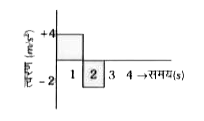If the position vector of the particle is given by →r=3ˆt2ˆi+5tˆj+4ˆk, Find the
(a) The velocity of the particle at t=3s
(b) Speed of the particle at t= 3s
(c) Acceleration of the particle at time t=3sSolution in Tamil
The velocity →v=d→rdt=dxdtˆj+dzdtˆk
We obtain →v(t)=6tˆi+5ˆj
The velocity has only two components vx=6t, depending on time and vy=5 which is independent of time.
The velocity at t=3s is →v(3)=18ˆi+5ˆj
(b) The speed at t=3s is
v=√182+52=√349=18.68ms−1
(c) The acceleration →a is, →a=d2→rdt2=6ˆi
The acceleration has only the x-component. Note that acceleration here is independent of t, which means →a is constant. Even at 1=3s it has same value →a+6ˆi. The velocity is non-uniform, but the acceleration is uniform (constant) in this case.
Topper's Solved these Questions
- KINEMATICSBOOK - FULL MARKSCHAPTER - KINEMATICSEXERCISE - TEXTUAL QUESTIONS SOLVED (MULTIPLE CHOICE QUESTIONS:)
30 Videos
- KINEMATICSBOOK - FULL MARKSCHAPTER - KINEMATICSEXERCISE - TEXTUAL QUESTIONS SOLVED (SHORT ANSWER QUESTIONS)
30 Videos
- HEAT AND THERMODYNAMICSBOOK - FULL MARKSCHAPTER - HEAT AND THERMODYNAMICSEXERCISE - ADDITIONAL QUESTIONS SOLVED (Numerical Problems)
16 Videos
- KINETIC THEORY OF GASESBOOK - FULL MARKSCHAPTER - KINETIC THEORY OF GASESEXERCISE - Addtional Numerical Problems
10 Videos
Similar Questions
Which one of the following Cartesian coordinate systems is not follwed in physics?
View SolutionWhat is meant by Cartesian coordinate system?
View SolutionThe length of a metal wire is l1 when the tension in it is T1 and is l2 when the tension is T2. The natural length of the wire is:
View SolutionIf the rms speed of hydrogen molecules at 300K is1930ms−1. Then what is the rms speed of oxygen molecules at 1200K.
View SolutionFigure shows the speed versus time graph for a particle. Find the distance travelled by the particle during the time t=0 to t=3s.

View SolutionThe x-t graph of a particle undergoing simple harmonic motion is shown below. The acceleration of the particle of t=4//3s is
View SolutionThe momentum p (in kg ms^(-1) ) of a particle is varying with time t (in second) as p=2+3 t^(2) . The force acting on the particle at t=3s will be
View SolutionVelocity of a particle is given as v=(2t2−3)m/s. The acceleration of particle at t = 3s will be :
View SolutionThe x-t graph of a particle undergoing simple harmonic motion is shown below. The acceleration of the particle at t = 2/3s is
View SolutionThe position vector for a particle is represented be →r=3t2ˆi+5tˆj+6ˆk, find the velocity and speed of the particle at t=3 sec.
View SolutionIf the position vector of the particle is given by vecr = 3 t^2 hati + 5t hatj + 4hatk . Find the velocity of the particle at t = 3s.
View SolutionThe displacement vs time graph of a particle undergoing S.H>M. Is shown below . The acceleration of the particle at t=2/3s is

View SolutionA particle is moving with an intial velocity of 5ms−1. What will be the velocity of the particle at t=3s, if the acceleration of the particle is given by
a=16t3−12t2+6t−25
View Solutionएक कण t=0 पर विराम से गति प्रारम्भ करता है तथा नीचे प्रदर्शित ग्राफ के अनुसार सरल रेखा में त्वरित गति करता है। कण का t = 3s पर वेग है

View SolutionThe positon of an object moving along x-axis is given by x(t)=(4.2t2+2.6)m, then find the velocity of particle at t=0sandt=3s, then find the average velocity of particle at t =0 s →t =3s.
View Solution
